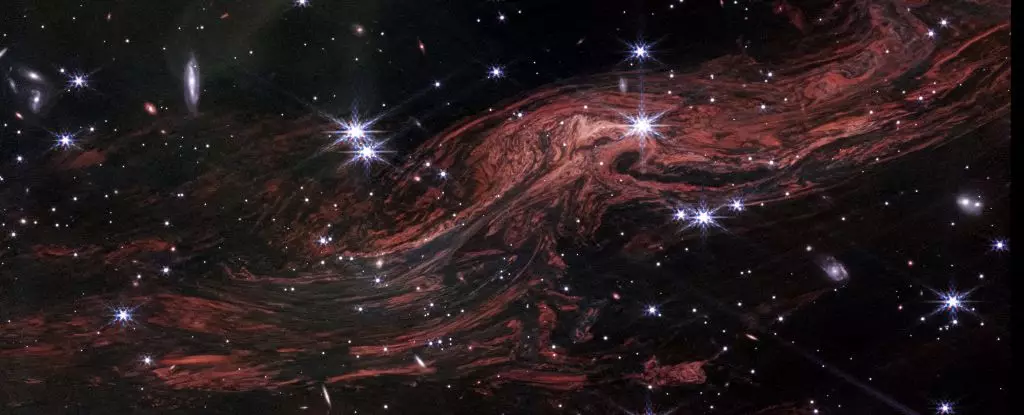In a remarkable triumph for modern astronomy, the James Webb Space Telescope (JWST) has unveiled unprecedented details of the interstellar medium surrounding the remnants of a star explosion, known as Cassiopeia A. Through its advanced imaging capabilities, JWST allows scientists to delve into the subtle compositions and dynamics of the dust and gas that intersperse the cosmos. This article explores how these new findings not only enhance our understanding of stellar remnants but also signify a paradigm shift in the study of the interstellar medium.
Recent observations from JWST have brought to light the intricate structures of dust particles soaring between stars. This dust, often overlooked due to its faint emissions, plays a pivotal role in the galactic ecosystem. The explosion of Cassiopeia A, which occurred approximately 11,000 light-years away, has created ripples in the surrounding medium that JWST can now observe with mesmerizing clarity. As the light emitted from this cosmic event traveled through the interstellar dust, it reflected and warmed the particles it encountered, giving rise to a faint red glow that was previously unaided by older telescopes.
The complex interplay of light and dust has always been a tantalizing subject for astronomers, yet the themes of this celestial ballet have remained largely elusive. The JWST’s ability to capture infrared light allows astronomers to visualize this phenomenon in ways that previous observational tools could not. The telescope has made it possible to study the structure of the interstellar medium with an intensity and depth that reveals the defining features of this cosmic material; the whorls and sheets formed by dust present a captivating picture of our universe’s hidden architecture.
A particularly striking aspect of JWST’s findings is the phenomenon of light echoes. These occur when a brilliant flash of light encounters a barrier, resulting in a reflection that travels through space. Just as sound reverberations create echoes, light travels through the vast expanse of the universe, illuminating previously unseen structures in its path. Light echoes offer astronomers a powerful tool to map the locations and compositions of various cosmic materials.
Most light echoes detected historically have stemmed from vibrant astrophysical events or involved dense environments close to the source. The challenge has often been to observe thinner, more dispersed clouds of dust that are situated further from the illuminating source. JWST excels in this regard, having successfully observed a wisp of distant dust associated with Cassiopeia A—a structure identified by NASA’s earlier Spitzer Space Telescope, albeit with significantly less detail.
The new data has captivated astronomers, with some noting the astonishment at the intricate layers and patterns found in this dust. These layers resemble the contours of tree rings, suggesting that the inner workings of cosmic structures may follow certain biological analogs found on Earth.
What sets this revelation apart is not just the visual details, but the implications of these findings for our understanding of the interstellar medium as a whole. The dense waves and knots of material observed may be influenced by cosmic magnetic fields. This connection posits that the evolving structures of light echoes can potentially yield insights into magnetized turbulence, an area of research with far-reaching consequences for astrophysics.
The metaphor drawn by astronomers who liken this research to a medical CT scan underscores the innovative nature of JWST’s capability. By capturing sequential images over a relatively short period, researchers are able to assess the three-dimensional architecture of the interstellar dust. With technology that permits an expansive view of interstellar structures, astronomers will have a tangible way to study cosmic phenomena that remain concealed from conventional observation.
As scientific discourse continues surrounding these findings, it is clear that the JWST’s contributions mark a transformative moment in our understanding of cosmic structures. The deeper insights into the interstellar medium and the mapping techniques related to light echoes create a promising horizon for future research. Each step taken towards comprehensively understanding these elements not only reflects on the nature of our universe but also signifies an evolving dialogue between advanced technology and human curiosity.
With ongoing studies and further analyses, the narrative surrounding Cassiopeia A and its surrounding celestial dust is just beginning to unfold. The findings presented during the recent American Astronomical Society meeting serve as a precursor for miles of new inquiry that await within the realms of astro-imaging and interstellar study. As we probe deeper into these cosmic marvels, we inch closer to unraveling the grand tapestry of the universe.


Leave a Reply